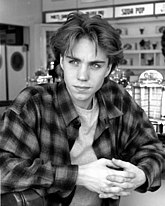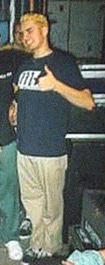Men’s fashion
Early 1990s (1990–1992)
Casual clothing
Continuing on from the late 1980s, many young men in the US, UK and Europe wore tapered and cuffed high waisted jeans or pants styled plain or pleated with matching denim jackets, Champion brand, Stone Island or Ralph Lauren sweatshirts, polo shirts with contrasting collars,[69] short Harrington jackets, grey Tommy Hilfiger sweaters with prominent logos,[70] oversized Guess (clothing) denim shirts, brightly colored windcheaters especially in yellow or green, Hush Puppies shoes.
Grunge look

From 1991 until 1996, flannel shirts became very popular in the US and Australia, due to their use among the skater subculture and grunge bands including Nirvana or Mudhoney.[77][78] Unlike the fitted Western shirts of the 1970s which fastened with pearl snaps, the flannel shirts of the 1990s were padded and loose-fitting for optimum warmth.[79] Men also wore acid wash jeans, patterned wool sweaters with turtlenecks underneath, black Schott Perfecto leather jackets, sheepskin coats, olive green anoraks, corduroy sportcoats, grey sweatpants and fingerless gloves.
Mid 1990s (1993–1996)
Cool Britannia and 1970s revival
Around 1995/1996, 1960s mod clothing and longer hair were popular in Britain, Canada, and the US due to the success of Britpop. Men wore Aloha shirts,[81] brown leather jackets, velvet blazers, paisley shirts, throwback pullover baseball jerseys, and graphic-print T-shirts (often featuring dragons, athletic logos or numbers). Real fur went out of fashion and fake fur became the norm.[34]
Modern preppy

Preppy clothing was popular in the US,[82] where wealthy young men wore khaki slacks, canvas[83] boat shoes, and navy blue blazers with breast-pocket monogram or gold buttons bearing a family crest.[83] In general, 1990s preppy was more casual than the almost dandified look of the 1980s as young men abandoned ascots and Oxford shoes in favor of Nantucket Reds, nautical-striped T-shirts, boat shoes i.e. Sperrys, loafers, white style casual sneakers, slouch socks, and madras cloth or gingham short-sleeved shirts.[84] Desirable brands included Gap, Old Navy and Abercrombie & Fitch.
Hip-Hop
In Europe and North America, hip-hop fashion went mainstream in 1992, with oversized baseball jackets, baggy jeans, bomber jackets, Baja Jackets, and tracksuits popular among young men as casual wear.[85] Simultaneously, industrial and military styles crept into mainstream fashion, with machinery pieces becoming accessories.[26] Baseball caps started being worn forwards again.[34]
Late 1990s (1997–1999)
African fashion
During the mid and late 1990s,[88] the silk Madiba shirt became popular in South Africa and the wider global community.[89] From 1996 to 1998, traditional African clothing began to face serious competition[90] from cheap imported mitumba clothing[91][92] as a consequence of the Kenyan and Tanzanian government’s easing of trade restrictions during the early to mid 1990s.[93] By the end of the decade, the safari jacket associated with kleptocrat dictator Mobutu Sese Seko of the Democratic Republic of the Congo and the previous South African Apartheid regime had declined in popularity, and was replaced as formal wear by the dashiki suit.[94] Variants in green, yellow and black were worn as an alternative to the business suit by many African-Americans[95] for Kwanzaa.
Streetwear

By the late 1990s, the grunge look became unfashionable, and there was a revival of interest in streetwear clothing, with name brand designers such as Calvin Klein and Ralph Lauren making a comeback.[26] In Europe, jeans were more popular than ever before.[67] From 1997 to 1998 brighter colors came into style, including plum, charcoal, olive, wine,[64][98] and shades such as “camillia rose”, “blazing orange”, “whisper pink”, “hot coral”, and a light-grayish blue called “wind chime”.
Business wear
In Europe, single-breasted three and four button notch lapel suits in grey or navy blue, together with leather jackets based on the same cut as blazers, began to replace the double breasted 1980s power suits. The wide neckties of the early 1990s remained the norm, but the colors became darker and stripes and patterns were less common. In India and China, the Nehru suit and Mao suit declined in popularity in favor of conventional Western business wear.[99] Tweed cloth and houndstooth sportcoats went out of fashion due to their association with older men.[100] Dress shoes (usually in black) included chelsea boots with rounded or square toes, wingtips, and monkstraps.[64]